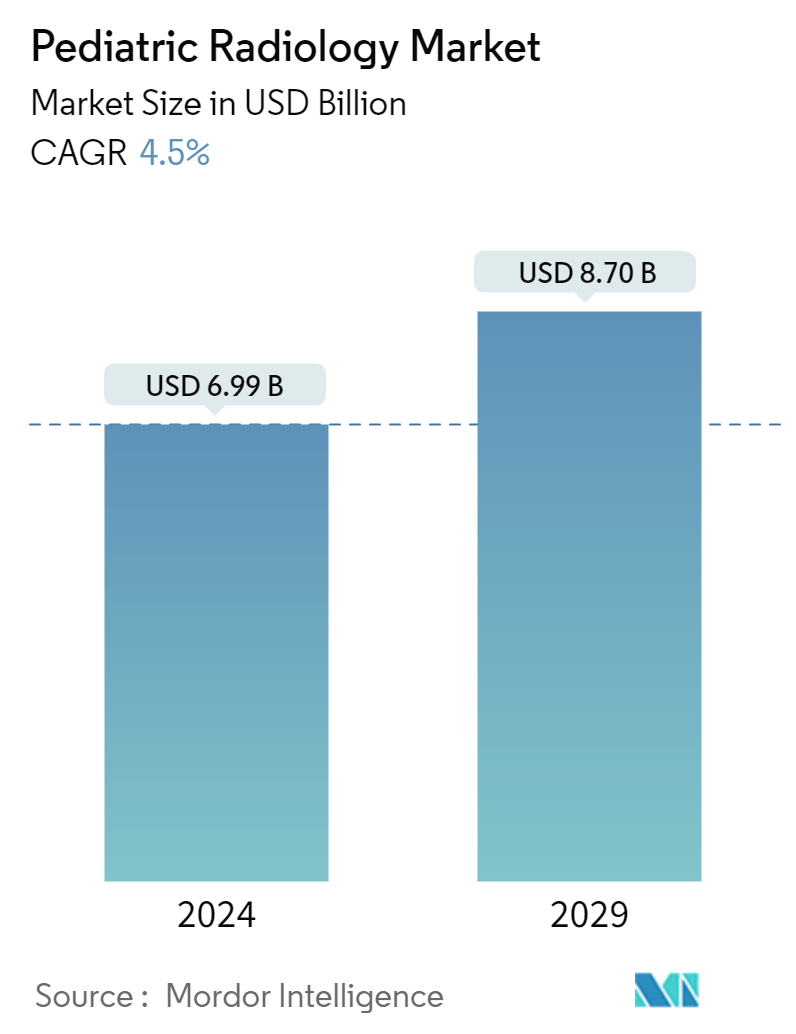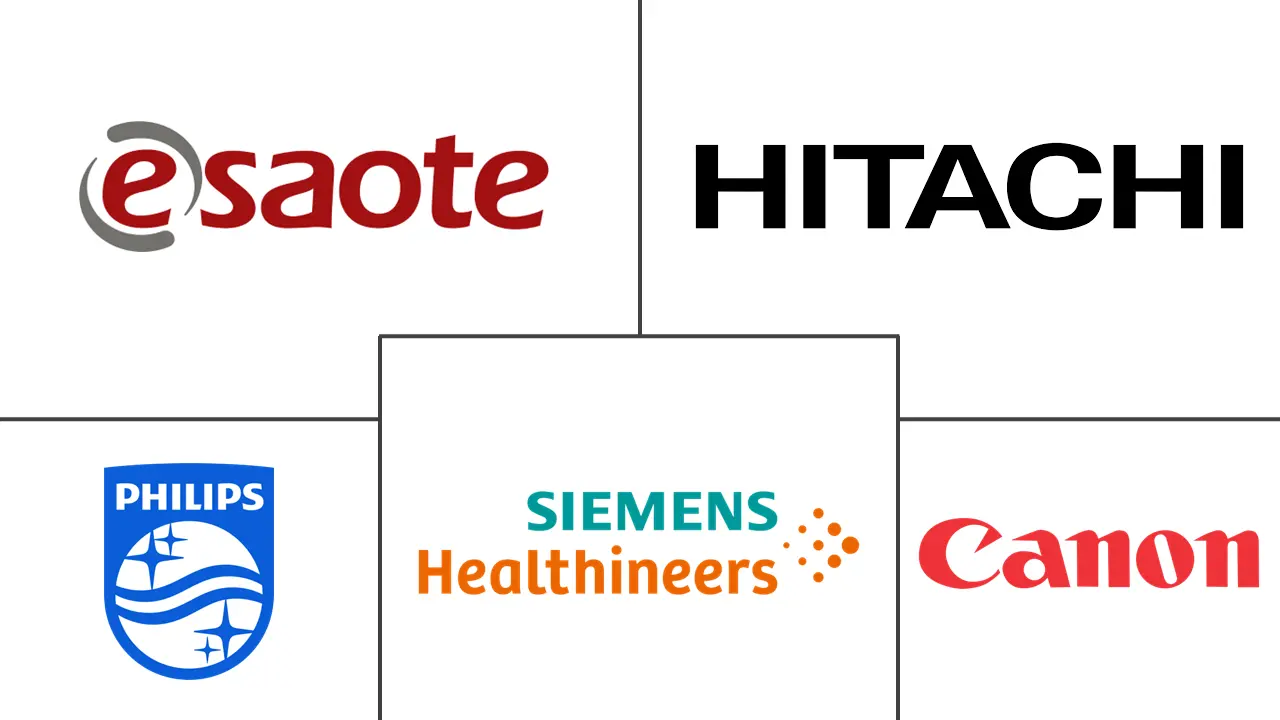Market Size of Pediatric Radiology Industry

| Study Period | 2019 - 2029 |
| Market Size (2024) | USD 6.99 Billion |
| Market Size (2029) | USD 8.70 Billion |
| CAGR (2024 - 2029) | 4.50 % |
| Fastest Growing Market | Asia Pacific |
| Largest Market | North America |
| Market Concentration | Medium |
Major Players
*Disclaimer: Major Players sorted in no particular order |
Pediatric Radiology Market Analysis
The Pediatric Radiology Market size is estimated at USD 6.99 billion in 2024, and is expected to reach USD 8.70 billion by 2029, growing at a CAGR of 4.5% during the forecast period (2024-2029).
The major factors driving the market's growth include the increasing burden of pediatric diseases, such as coronary heart failure and pneumonia, the rise in affordability, and increased government initiatives and research and development activities to develop advanced pediatric radiology devices.
Pneumonia is one of the major chronic diseases observed in younger children. For instance, according to a report published by UNICEF in November 2023, globally, there are over 1,400 cases of pneumonia per 100,000 children, or 1 case per 71 children every year, with the most significant incidence occurring in South Asia (2,500 cases per 100,000 children) and West and Central Africa (1,620 cases per 100,000 children). One of the most common chronic diseases in children is pneumonia, increasing the demand for medical diagnostic imaging, thereby boosting the market growth.
Similarly, an increase in asthma cases in children is observed, propelling the market's growth. For instance, the Journal of Asthma and Allergy in January 2023 indicated that the worldwide prevalence of asthma stands at 11% for children aged 6-7 years and 9.1% for those aged 13-14 years. Also, there is a suggested correlation between asthma and lower academic performance. The rising cases of asthma among children are creating a demand for novel diagnostics technologies, thereby propelling the pediatric radiology market.
The key players in the market are focusing on different growth strategies, such as collaboration for the installation of novel products in different healthcare facilities, which are expected to drive the market. For instance, in July 2023, Eyas Medical Imaging installed its neonatal MRI system Ascent within Cincinnati Children's Hospital's neonatal intensive care unit (NICU). The Ascent utilizes a 3-tesla magnet, which results in improved accuracy in neonatal diagnostic imaging. This improvement could enhance patient treatment plans and better outcomes for vulnerable infants. This will further improve the adoption of pediatric radiology systems in developed countries, thus leading to lucrative market growth.
In conclusion, the increasing cases of chronic diseases and increased government initiatives are propelling the market's growth during the forecast period. However, ethical issues in pediatric research and a need for more skilled healthcare professionals are expected to hinder the market's growth during the forecast period.
Pediatric Radiology Industry Segmentation
As per the report's scope, pediatric radiology is an imaging specialism in diagnostic radiology focused on children and fetuses. Adolescents are referred to pediatric radiologists because growing bodies are more susceptible to the adverse effects of radiation than adults of equivalent size. The pediatric radiology market is segmented by product type, modality, end user, and geography. The product type segment is further segmented into ultrasound, MRI, X-ray, computed tomography scanner, and other product types. The modality segment is divided into standalone, table-top devices, and portable devices. The end user segment is further bifurcated into pediatric clinics, diagnostic centers, hospitals, and other end users. The geography segment is divided into North America, Europe, Asia-Pacific, Middle East and Africa, and South America. The report also covers the estimated market sizes and trends for 17 countries across major regions globally. The report offers the value (in USD) for the above segments.
| By Product Type | |
| Ultrasound | |
| MRI | |
| X-ray | |
| Computed Tomography Scanner | |
| Other Product Types |
| By Modality | |
| Standalone Devices | |
| Table-top Devices | |
| Portable Devices |
| By End User | |
| Pediatric Clinics | |
| Diagnostic Centers | |
| Hospitals | |
| Other End Users |
| Geography | ||||||||
| ||||||||
| ||||||||
| ||||||||
| ||||||||
|
Pediatric Radiology Market Size Summary
The pediatric radiology market is poised for significant growth, driven by the increasing prevalence of pediatric diseases and the rising demand for advanced diagnostic imaging technologies. The market is experiencing a surge in demand due to the high incidence of chronic conditions such as pneumonia and asthma among children, which necessitate the use of medical imaging for accurate diagnosis and treatment. Additionally, the growing burden of premature births is further propelling the market, as MRI and other imaging technologies are essential for diagnosing and managing complications in preterm infants. Government initiatives and research advancements are also contributing to the development of innovative pediatric radiology devices, enhancing the market's growth prospects.
North America is expected to maintain a substantial share of the pediatric radiology market, with the United States and Canada leading the region. The market's expansion is supported by technological advancements, strategic collaborations, and the introduction of new products aimed at improving pediatric care. Key players in the market are focusing on enhancing their product offerings and expanding their distribution channels to capture a larger market share. Despite the promising growth trajectory, challenges such as ethical concerns in pediatric research and a shortage of skilled healthcare professionals may pose hurdles to market expansion. Overall, the pediatric radiology market is set to experience robust growth, driven by the increasing demand for specialized imaging technologies and supportive government policies.
Pediatric Radiology Market Size - Table of Contents
-
1. MARKET DYNAMICS
-
1.1 Market Overview
-
1.2 Market Drivers
-
1.2.1 Increasing Burden of Pediatric Diseases, such as Coronary Heart Failures, Pneumonia, and Rise in Affordability
-
1.2.2 Increased Government Initiatives and R&D Activities to Develop Advanced Pediatric Radiology Devices
-
-
1.3 Market Restraints
-
1.3.1 Ethical Issues in Pediatric Research
-
1.3.2 Lack of Skilled Healthcare Professionals
-
-
1.4 Porter's Five Forces Analysis
-
1.4.1 Bargaining Power of Buyers/Consumers
-
1.4.2 Bargaining Power of Suppliers
-
1.4.3 Threat of New Entrants
-
1.4.4 Threat of Substitute Products
-
1.4.5 Intensity of Competitive Rivalry
-
-
-
2. MARKET SEGMENTATION (Market Size by Value - USD)
-
2.1 By Product Type
-
2.1.1 Ultrasound
-
2.1.2 MRI
-
2.1.3 X-ray
-
2.1.4 Computed Tomography Scanner
-
2.1.5 Other Product Types
-
-
2.2 By Modality
-
2.2.1 Standalone Devices
-
2.2.2 Table-top Devices
-
2.2.3 Portable Devices
-
-
2.3 By End User
-
2.3.1 Pediatric Clinics
-
2.3.2 Diagnostic Centers
-
2.3.3 Hospitals
-
2.3.4 Other End Users
-
-
2.4 Geography
-
2.4.1 North America
-
2.4.1.1 United States
-
2.4.1.2 Canada
-
2.4.1.3 Mexico
-
-
2.4.2 Europe
-
2.4.2.1 Germany
-
2.4.2.2 United Kingdom
-
2.4.2.3 France
-
2.4.2.4 Italy
-
2.4.2.5 Spain
-
2.4.2.6 Rest of Europe
-
-
2.4.3 Asia-Pacific
-
2.4.3.1 China
-
2.4.3.2 Japan
-
2.4.3.3 India
-
2.4.3.4 Australia
-
2.4.3.5 South Korea
-
2.4.3.6 Rest of Asia-Pacific
-
-
2.4.4 Middle East and Africa
-
2.4.4.1 GCC
-
2.4.4.2 South Africa
-
2.4.4.3 Rest of Middle East and Africa
-
-
2.4.5 South America
-
2.4.5.1 Brazil
-
2.4.5.2 Argentina
-
2.4.5.3 Rest of South America
-
-
-
Pediatric Radiology Market Size FAQs
How big is the Pediatric Radiology Market?
The Pediatric Radiology Market size is expected to reach USD 6.99 billion in 2024 and grow at a CAGR of 4.5% to reach USD 8.70 billion by 2029.
What is the current Pediatric Radiology Market size?
In 2024, the Pediatric Radiology Market size is expected to reach USD 6.99 billion.

